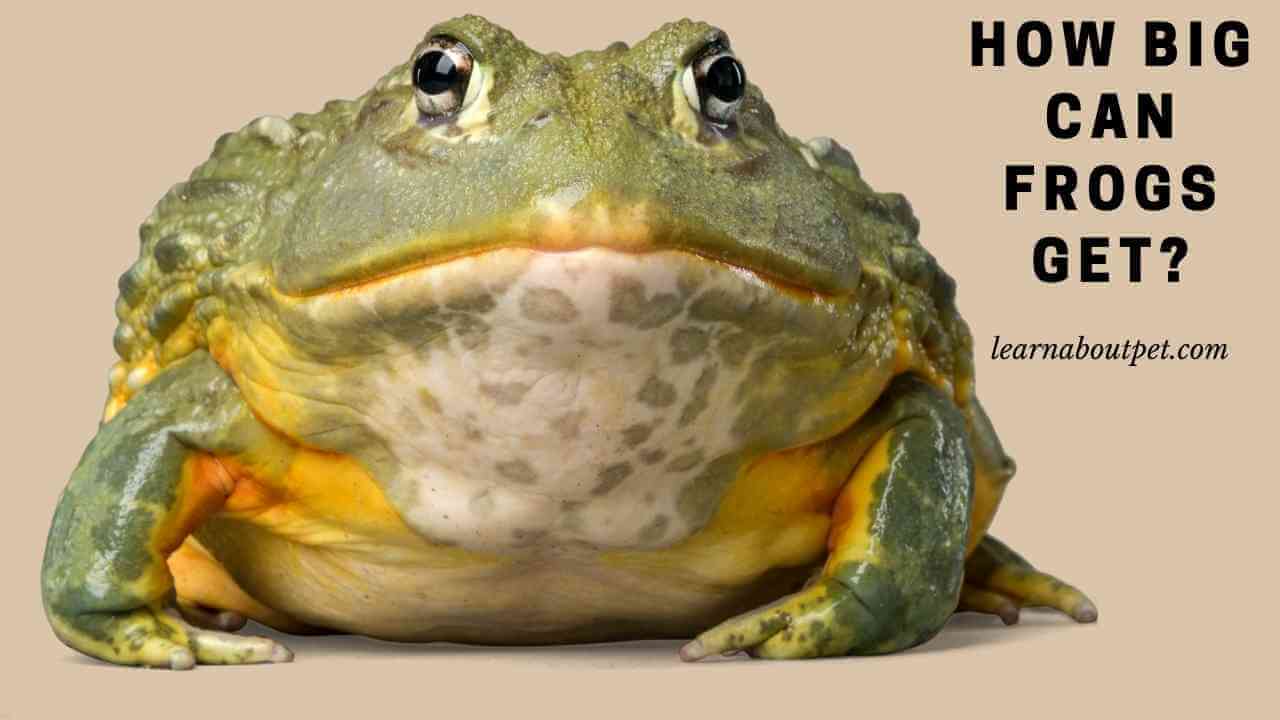People who are considering keeping frogs as pets often express interest in knowing how big these amphibians can get. We also have individuals who just want to know how big frogs can grow out of curiosity. Read on, to find out how large frogs can get, as well as the factors that determine how big they actually grow to be.
How big can frogs get? Well, frog sizes vary considerably as they metamorphose from eggs to tadpoles to toadlets and onto adults. We have some species whose adult size is on average just 0.77 centimeters. On the other extreme, we have species whose adult sizes have been documented at 42.5 centimeters – which, at around 16.7 inches, is more than a foot! In terms of weight, we are looking at as little as 0.3 ounces to as much as 98 ounces.
The specific size of a frog will depend on its species and the growth stage it is at. It will also depend on its gender and the conditions it is living under.

How Big Can Frogs Get?
Frogs can grow to more than one foot in snout to vent length. This is the case, for instance, for the now extinct Beelzebufo – whose reconstructions show that it grew to as much as 16.7 inches (42.5 centimeters). The said Beelzebufo Ampinga frog, which was the largest frog ever, could attain as much as 4.5 kg in weight. But that species is now extinct. Currently, the largest frog in the world is the Goliath frog, which grows up to an impressive 32 centimeters (around 12.5 inches).
Thus, when answering the how big can frogs get question, it is important to point out that frogs can grow to very impressive sizes. To be sure, the truly big frog species are relatively few and therefore hard to encounter. But they exist: frogs that are more than one foot in length!
Of course, while answering the how big can frogs get question, it is also imperative to mention that there are also frogs that grow to impressively small sizes. There are some species in which you will find a fully grown adult that is less than one centimeter. And that is actually in snout to vent length! This is the case, for instance, in the paedophryne amauensis, which many term as the smallest frog in the world, with average length of around 0.77 centimeters.
Therefore, it is possible to encounter a very big frog – that is more than one foot long. It is also possible, on the other extreme, to encounter a fully grown frog that is less than one inch long. Any fully comprehensive frog size chart would therefore have very huge variation. (But then again, it is important to avoid confusing a frog bike size guide for an actual frog size chart).
Average Size Of Frogs By Their Species
Perhaps a good way of getting answers to the how big can frogs get question would be by looking at average size of frogs by their species. This is where, for instance, we come to discover that the average size of the Goliath frog is at around 28.5 centimeters length, and 2.8 kg weight. An African Bullfrog, another impressively big frog, can attain the length of 22.86 centimeters (around 9 inches). In terms of weight, it goes up to 1.9 kg (roughly 70.4 ounce).
Turning to more common frogs, we have the likes of the Wood Frog, which on average grows to 2 inches length (5.1 cm). Its weight is, on average, 0.28 ounce, which works out to around 7.8 grams).
For the poison dart frog, length on average is 3.75 cm (1.47 inch), with weight at an average of 1 ounce (28.3 grams).
Turning to the truly small frogs, we have the paedophryne amauensis, whose length on average is 0.30 inches (0.77 centimeters).
Thus, it is clear that there is a truly wide variation, when it comes to average frog size. And that is hardly surprising, when we consider the fact that there are more than 7,000 frog species in existence.
When Is A Frog Fully Grown?
While dealing with the how big can frogs get question, it is good to mention something with regard to when a frog is considered to be fully grown. So, when is a frog fully grown? Well, a frog is said to be fully grown when it has gone through all life stages: from egg to tadpole to toadlet and onto fully grown adult. This is a process that can take between 2 to 4 years in some species.
It is also worth pointing out that a frog can still continue growing, even after attainment of maturity.
What Are The Important Factors That Determine Frog Size?
In trying to understand how big do frogs get, it is imperative to examine the factors that influence their growth. As it turns out, frog size greatly depends on the frog species. How frogs grow also depends on their gender and environment. Diet quality and life cycle stages are also important determinants of frog size. We will now proceed to look at each of these factors in turn.
Life Cycle Stages Determining Frog Size
The size of a frog obviously depends on what life stage it is at. You can’t expect a newly hatched tadpole to be the same size as a fully grown adult of the same species. But sometimes, you may find a newly hatched tadpole of one species being bigger than a fully grown adult frog of another species.
For instance, a new bullfrog hatchling may be bigger than a complete adult spring peeper. But within one species, the mature/adult frogs will tend to be bigger than the younger frogs.
Frog Species Determines Frog Size
Species is arguably the biggest determinant of frog size. There are some species that are very big in size. For instance, the largest frog ever recorded (the Beelzebufo) could grow to an average of 16.7 inches. That is roughly 42.5 centimeters. Now compare that with the paedophryne amauensis, which on average grows to just 0.30 inches, which is roughly 0.77 inches…
On the whole, bullfrogs will tend to be very big in sizes. On the other hand, tree frogs, which like to hang on tree leaves, will tend to be rather small in size. Aquatic frogs will tend to be of medium size.
All in all, all other factors being constant, species is the main determinant of frog size. This is why people who pose the how big can frogs get question are usually asked to be more specific about the species.
That is both with regard to how long a frog grows to be and how much does a frog weigh? Thus, if you ask a herpetologist how much does a frog weigh, chances are that he will ask you to be more specific about the frog species.
It can be impossible to answer the how much does a frog weigh question without insight on the frog’s species. Similarly, it is pretty much impossible to answer the question on how big can frogs get without insight on the species that is under consideration.
Diet Quality Determines Frog Size
A frog needs to get adequate quality food, for it to attain its full growth potential. A frog that would otherwise have grown to an impressive size may actually get stunted if adequate quality food isn’t available for it.
Sometimes, a frog from a species that is normally quite small may outgrow another one of a species that is normally quite big. This may happen if the latter is getting a proper diet, while the other frog doesn’t get proper food.
Frog Gender Determines Frog Size
In some frog species, you tend to find that the males are bigger than the females. In other species, you find that the females are bigger than the males. The latter scenario (of females being larger) actually seems to be more common. And this is understandable, when you consider the logistics of frog mating.
Frog mating often entails the females having to carry the males on their backs for considerable periods of time. Thus, it makes sense for the males to be smaller and lighter.
Environment Quality Determines Frog Size
A frog needs optimum environmental conditions, for it to attain its full growth potential. A frog that would otherwise have grown to an impressive size may experience stunted growth, if placed in a suboptimum environment.
In fact, it is possible for a frog from a species that is normally quite small to become attain a larger size than another frog from a species that is normally quite big, on account of environmental conditions variation.
How Big Can African Dwarf Frogs Get?
After answering the how big can frogs get question at a general level, we can now turn to specific species. In this regard, we will start with the African dwarf frog. As it turns out, the African dwarf frog typically grows up to 3 inches (7.5 centimeters) in length. Therefore if you take a young African dwarf frog with the intention of keeping it as a pet, that is how long you should expect it to grow to be.
How Big Can Bullfrogs Get?
Bullfrogs tend to be among the biggest types of frogs. For this reason, the question on how big can a bullfrog get comes up very often whenever there are frog size discussions. So, just how big can a bullfrog get? Well, bullfrogs can grow up to 13 inches (32 centimeters) in length. The biggest bullfrog ever found would probably be the Beelzebufo Ampiga, which attained up to 16.7 inches (42.5 centimeters) length: but it is extinct.
Most of the people who pose the how big can a bullfrog get question tend to have an interest in existing, rather than extinct bullfrog species. Indeed, people will often pose the how big do bullfrogs get question after watching documentaries featuring these impressively big frogs. So, just how big can a bullfrog get (with regard to the existing, rather than extinct species)?
Well, with regard to existing species, it emerges that the African bullfrog is the biggest. And it usually grows to 24.5 centimeters (9.6 inches) length.
How Big Can Pacman Frogs Get?
Typically, Pacman frogs will grow to between 4 and 8 inches size. But the size that a pet Pacman frog actually attains will depend on things like the conditions one is keeping it under, its diet and health.

How Big Can Tree Frogs Get?
Whenever there is a discussion on how big can frogs get, the issue of tree frog size and weight tends to come up. So, just how big do tree frogs get? Well, at the outset, it is good to point out that there are very many tree frog species. Therefore the question on how big can a tree frog get is not one that is always easy to answer. Some tree frogs are quite big, even as other are quite small.
Nonetheless, tree frogs tend to be generally small – which makes sense when you consider the habitat they live in. The white lipped tree frog, which many regard as the biggest tree frog, can attain 4-5.5 inch (10-14 centimeter) length. Typical tree frogs, however, will tend to be in 1-2 inches length range, with weight in the 7-10 grams range. That makes it easy for them to hop from lea to leaf, and from the ground to tree branches.
How Big Can African Clawed Frogs Get?
Another name that tends to come up, whenever the how big can frogs get question is being discussed is that of African clawed frogs. This is because many people consider this frog an ideal pet, thanks to its longevity (up to 25 years). So, how big can an African clawed frog get? Well, a female will typically grow up to 4.5 inches in length. A male will typically grow up to 2.5 inches in length.
In terms of weight, females typically attain up to 200 grams, while males will typically only attain around 60 grams.
How Big Can Green Tree Frogs Get?
A discussion on how big can frogs get will probably be incomplete if it doesn’t touch on green tree frogs. That is because these too are popular pets. As it turns out, green tree frogs are quite modest in size. Their body length is typically in the 1.25 to 2.5 inches range. Therefore, if you are keeping a green tree frog as a pet, don’t expect to grow to a foot long!
By the way, some people consider the green tree frogs to be ‘toads’. Thus, whenever there is a discussion on how big do toads get (or how big can toads get), the green tree frogs may also come up. And as we have seen, the size is modest: typically in the 1.25 to 2.5 inches range. Thus, the green tree frogs come up both in how big do frogs grow discussions and how big do toads grow discussions.
How Big Can White Tree Frogs Get?
White tree frogs tend to be in the category of frogs that are capable of attaining moderate sizes. The snout to vent lengths for white tree frogs are usually in the 3 to 4.5 inches range. This converts to between 7 and 11.5 centimeters.
How Big Can Green Frogs Get?
Typically, green frogs (Lithobates clamitans species) manage to attain the snout to vent length of between 2 and 3.9 inches. Thus, green frogs can actually get as big as 3.9 inches. If you are considering taking up a green frog as a pet, this is the sort of growth to expect.
How Big Can Pixie Frogs Get?
Another name that typically comes up whenever there are discussions on how big can frogs get is that of the pixie. Pixies may not exactly be a giant frog species, but they can attain remarkably big sizes. They often grow to between 4.5 and 10 inches. A 10 inch frog is truly quite a sight.
How Big Do Dart Frogs Get?
Dart frogs usually only manage to attain modest sizes. The most you can typically expect from a dart frog is around 2.5 inches. But the average is in the 0.5 to 1.5 range.
What Is The Biggest Frog In The World?
It would be unfair to conclude a discussion on how big can frogs get without answering, in plain terms, the question on what is the largest frog species? This is also where we get a chance to know how big is the biggest frog in the world?
So, indeed, what is the largest frog in the world? Well, the Goliath frog is the largest frog in the world. On average, it grows to around 11.2 inches, which converts to 28.5 centimeters. In terms of weight, the average weight of a bullfrog in the Goliath species is 98.7 ounces, which converts to around 2.8 kg. The said Goliath frog size is truly impressive with big frog feet and frog butt, when you come to think of it. Even more impressive is the fairly rapid Goliath frog life cycle.
The Goliath frog is, however, not the largest frog ever. That honor goes to the now extinct Beelzebufo Ampingo frog. They have an unique sound to them and enjoy climbing walls. Do you know about Xenomorph frog? They are not real.
Thus, when people pose the question on what is the largest species of frog in the world currently, they are pointed to the Goliath frog. And with an average frog weight of 2.8 kg, the Goliath is truly a remarkable creature. That is for the lucky few who get a chance to lay their eyes on one.
It is important to mention that Goliath frogs are facing extinction. This becomes patently clear if you conduct research on how many goliath frogs are left in the world (and where is the goliath frog found or where do goliath frogs live)?
With regard to where they live, it is clear that they are only in a few habitats. That is mostly in Cameroon and Equatorial Guinea. And with regard to their numbers, it is clear that they are fast dwindling. This, after all, is a frog that people often hunt for food.
What Is The Smallest Frog In The World?
Before concluding a discussion on how big can frogs get, it would be only fair to say something about the smallest frog. And that honor goes to the Paedophryne amauensis, which some people also refer to as the mini mum. It is less than a centimeter in size!
That is certainly not the sort of figure most people have in mind when they pose the how big is a frog question. But there you have it: with a mini mum averaging at 0.3 inch (0.77 cm) in adult size.
Final Verdict – How Big Can Frogs Get
How big can frogs get? frogs can grow to impressive sizes. There are species like the Goliath frog that can actually grow to almost a foot in length (and more than 2.8 kg in weight). But most other frog species tend to only attain more modest sizes.

While kept as a pet, how big a frog grows will depend on its species, its gender and how well it is fed – as well as how optimum its environment is.

Welcome to Learn About Pet. My name is Rajkumar Ravichandran and I love all pets, travel, and amazing food. I write about my passion and personal experience caring for multiple pets in this blog! ❤️
Post Disclaimer
DISCLAIMER: THIS BLOG OR WEBSITE, "Learn About Pet", DOES NOT PROVIDE YOU WITH MEDICAL ADVICE AND IS NOT A SUBSTITUTE FOR MEDICAL ADVICE. ALWAYS GET IN TOUCH WITH YOUR PERSONAL VETERINARIAN AND USE INFORMATION HERE AS GENERAL ADVICE.
The information, including but not limited to, text, graphics, images and other material contained on this website are for informational purposes only. No material on this site is intended to be a substitute for professional veterinary advice, food recommendation, diagnosis, or treatment. Always seek the advice of your veterinarian or other qualified health care provider with any questions you may have regarding a medical condition or for pet food related questions.







